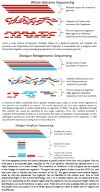The bladder is not sterile: History and current discoveries on the urinary microbiome
- PMID: 27182288
- PMCID: PMC4864995
- DOI: 10.1007/s11884-016-0345-8
The bladder is not sterile: History and current discoveries on the urinary microbiome
Abstract
In the human body, there are 10 bacterial cells for every one human cell. This fact highlights the importance of the National institutes of Health's initiative to map the human microbiome. The Human Microbiome Project was the first large-scale mapping of the human microbiome of 5 body sites: GI tract, mouth, vagina, skin and nasal cavity using culture-independent methods. The bladder was not originally tested because it was considered to be sterile and there were complexities regarding sample collection. Over the last couple years our team along with other investigators have shown that a urinary microbiome exists and for most individuals it plays a protective role.
Keywords: Urinary microbiome; bacteria; urgency incontinence.
Conflict of interest statement
Drs. Thomas-White, Brady, and Wolfe declare that they have no conflict of interest. Dr. Mueller reports consultancy fees and grants from Astellas.
Figures


References
-
- Duclaux E. Pasteur: The History of the Mind. Philidelphia and London: W.B. Saunders Company; 1920.
-
- Bloom DA, McGuire EJ, Lapides J. A brief history of urethral catheterization. The Journal of urology. 1994;151(2):317–25. - PubMed
Grants and funding
LinkOut - more resources
Full Text Sources
Other Literature Sources
